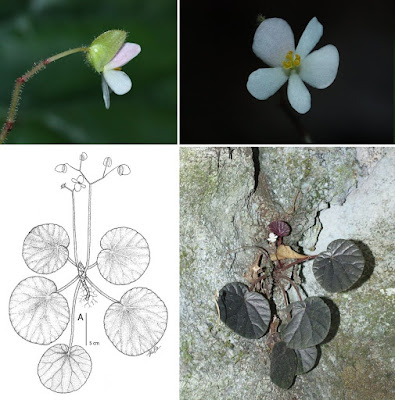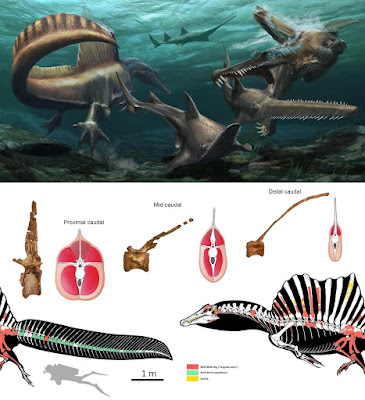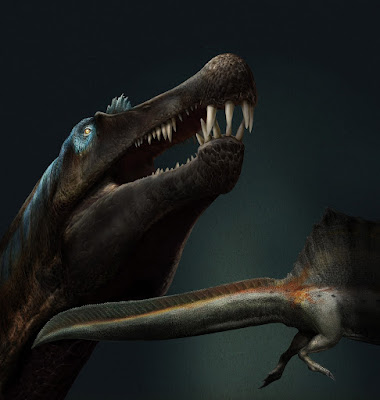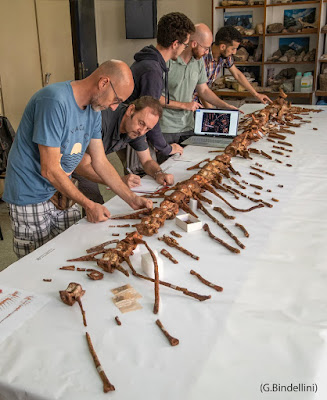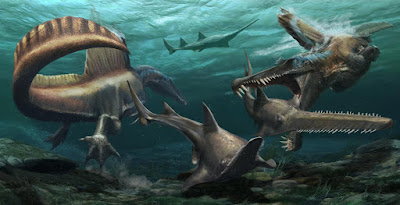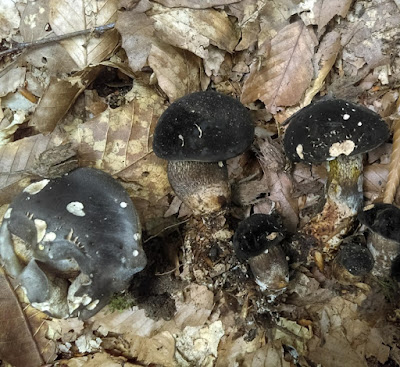[Most Recent Entries] [Calendar View]
Thursday, April 30th, 2020
| Time | Event | ||||||||
| 1:02a | [Botany • 2020] Begonia caramoanensis (sect. Baryandra, Begoniaceae) • A New Species from Camarines Sur, Philippines
Abstract Begonia caramoanensis from Caramoan, Camarines Sur, Luzon Island is described as a new species endemic to the Philippines. This is the latest addition to the species rich Begonia section Baryandra. It resembles Begonia madulidii but is distinguished by the dark green almost orbicular leaves; extensive inflorescence branching five times; and the glandular hairs of the bracts, peduncle, pedicels and ovary. More than 500 individuals, were observed in each of the four barangays of Caramoan, thus according to to the IUCN red list categories and criteria, B. caramoanensis is hereby proposed to be placed under Least Concern (LC) category. Keywords: Begoniaceae, Begonia section Baryandra, Caramoan, endemic, taxonomy, Eudicots
Rosario R. Rubite, Madeleine L. Irabagon, Diane Joy E. Palacio, Yu Pin Ang, Rene Alfred and Anton Bustamante. 2020. Begonia caramoanensis (sect. Baryandra, Begoniaceae) A New Species from Camarines Sur, Philippines. Phytotaxa. 439(3); 287–294. DOI: 10.11646/phytotaxa.439.3.10 | ||||||||
| 2:01a | [Herpetology • 2020] Eryx sistanensis • A New Species of Eryx (Serpentes: Erycidae) from Iran
Abstract We describe a new species of the genus Eryx Daudin, 1803 from southern Iran that is morphologically closely related to the Indian sand boa, E. johnii. The new species, Eryx sistanensis sp. nov. has a distribution range from Zabol in the Sistan Region to the southern parts of Sistan & Baluchistan, as well as Hormozgan Province of Iran. Morphologically, E. sistanensis sp. nov. differs from E. johnii by having fewer dorsal scale rows at midbody and the tail tip is not as blunt as E. johnii. The genetic distance (p-distance) between the new species and the Indian sand boa is considerable (9.1% for cytb and 11.8% for COI). Keywords: Serpentes, Eryx sistanensis sp. nov., molecular phylogeny, morphology, taxonomy
Eryx sistanensis sp. nov. Etymology: Eryx sistanensis sp. nov. is named after the Sistan Region in Sistan & Baluchistan Province, where the holotype was collected.
Distribution: Eryx sistanensis sp. nov. is currently known from Zabol in Sistan Region to the southern parts of Sistan & Baluchistan and Hormozgan Provinces (Fig. 7). Habitat: The specimens were observed in agricultural fields with soft substrates (Fig. 8). The farms were surrounded by natural vegetation such as Tamarix, Zygophyllum, Acacia and Chenopodiaceae shrubs. Naeimeh Eskandarzadeh, Nasrullah Rastegar-Pouyani, Eskandar Rastegar-Pouyani, Jamil Zargan, Ashkan Hajinourmohamadi, Roman A. Nazarov, Soheil Sami, Mahdi Rajabizadeh, Hossein Nabizadeh and Majid Navaian. 2020. A New Species of Eryx (Serpentes: Erycidae) from Iran. Zootaxa. 4767(1); 182–192. DOI: 10.11646/zootaxa.4767.1.8 | ||||||||
| 4:02a | [Paleontology • 2020] Spinosaurus aegyptiacus • Tail-propelled Aquatic Locomotion in A Theropod Dinosaur
Abstract In recent decades, intensive research on non-avian dinosaurs has strongly suggested that these animals were restricted to terrestrial environments. Historical proposals that some groups, such as sauropods and hadrosaurs, lived in aquatic environments were abandoned decades ago. It has recently been argued that at least some of the spinosaurids—an unusual group of large-bodied theropods of the Cretaceous era—were semi-aquatic, but this idea has been challenged on anatomical, biomechanical and taphonomic grounds, and remains controversial. Here we present unambiguous evidence for an aquatic propulsive structure in a dinosaur, the giant theropod Spinosaurus aegyptiacus. This dinosaur has a tail with an unexpected and unique shape that consists of extremely tall neural spines and elongate chevrons, which forms a large, flexible fin-like organ capable of extensive lateral excursion. Using a robotic flapping apparatus to measure undulatory forces in physical models of different tail shapes, we show that the tail shape of Spinosaurus produces greater thrust and efficiency in water than the tail shapes of terrestrial dinosaurs and that these measures of performance are more comparable to those of extant aquatic vertebrates that use vertically expanded tails to generate forward propulsion while swimming. These results are consistent with the suite of adaptations for an aquatic lifestyle and piscivorous diet that have previously been documented for Spinosaurus. Although developed to a lesser degree, aquatic adaptations are also found in other members of the spinosaurid clade, which had a near-global distribution and a stratigraphic range of more than 50 million years14, pointing to a substantial invasion of aquatic environments by dinosaurs.
Nizar Ibrahim, Simone Maganuco, Cristiano Dal Sasso, Matteo Fabbri, Marco Auditore, Gabriele Bindellini, David M. Martill, Samir Zouhri, Diego A. Mattarelli, David M. Unwin, Jasmina Wiemann, Davide Bonadonna, Ayoub Amane, Juliana Jakubczak, Ulrich Joger, George V. Lauder and Stephanie E. Pierce. 2020. Tail-propelled Aquatic Locomotion in A Theropod Dinosaur. Nature. DOI: 10.1038/s41586-020-2190-3 Bizarre Spinosaurus makes history as first known swimming dinosaur | ||||||||
| 10:55a | [Fungi • 2020] Tylopilus hayatae • A New Endemic Bolete Species (Basidiomycota: Agaricomycetes) in Relict Mexican Beech Forest
Abstract Tylopilus hayatae Rodríguez-Ramírez & Luna-Vega, sp. nov., is an ectomycorrhizal fungus found in relict Mexican beech forest (Fagus grandifolia subsp. mexicana) in the mountains of Hidalgo State, Sierra Madre Oriental, in eastern Mexico. We propose this new species based on morphological and molecular data evidence. Macro- and microscopic descriptions including illustrations, photographs and scanning electron micrographs of the basidiospores are presented. Keywords: ectomycorrhizal fungi, molecular phylogeny, tropical montane cloud forest, Fungi Ernesto Chanes Rodríguez-Ramírez, César Ramiro Martínez-González, Patricia Astrid González-Ávila and Isolda Luna-Vega. 2020. Tylopilus hayatae, A New Endemic Bolete Species in Relict Mexican Beech Forest. Phytotaxa. 441(1); 35–46. DOI: 10.11646/phytotaxa.441.1.3 |
| << Previous Day |
2020/04/30 [Calendar] |
Next Day >> |
